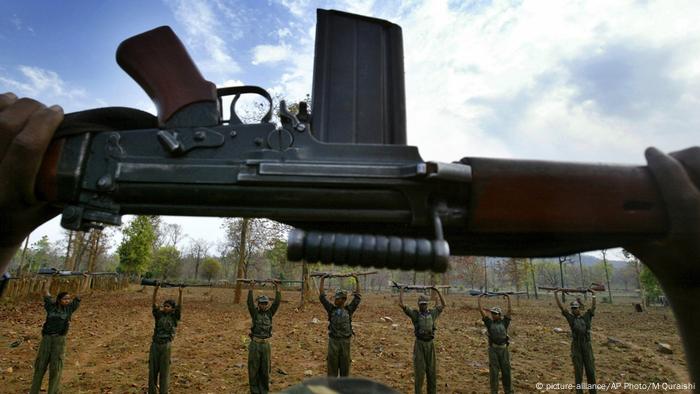India: Chhattisgarh conducts survey to map Maoist presence
The Maoists, considered India's biggest internal security threat, have waged an armed struggle against government forces for decades.
Indian security forces this year have stepped up operations against ultra-left-wing guerrillas deep in the forests of the mineral-rich central Indian state of Chhattisgarh, which has regularly seen clashes between the rebels and security forces in recent years.
The Maoists, also known as Naxals, have waged an armed struggle against government forces for decades. They are considered India's biggest internal security threat and operate in mineral-rich territory in the east and south of the country known as the "red corridor," which has shrunk over the years because of heavy operations against them.
The Maoists say they are fighting for the poor who have been left behind in India's economic boom.
Chhattisgarh, one of the fastest-developing states in India, has 28 varieties of major minerals, including diamonds and gold, a government website said. It also holds 16% of India's coal deposits and large reserves of iron ore and bauxite.
Police in one of the districts of Chhattisgarh have now published findings of a survey that maps out Maoist strongholds at the village level.
The survey, first launched in January, provided police personnel with a snapshot of the Maoist presence in the region. The investigation was followed up once again in July.
Results showed that 15 additional villages were free from militancy as compared to January's results. The study was conducted in Dantewada district, which comprises 149 villages. The district was once a hotbed of Maoist activity.

To counter the Maoist menace, successive Indian governments have put in place a policy clubbing police action with economic development
What's the purpose of the survey?
Though the strength of the Maoists has weakened in the region over the past two decades, clashes between police forces and the guerrillas have gotten more violent over the past few years.
Abhishek Pallava, the superintendent of police of Dantewada district, first thought of the survey because there was no data available at the village level to back claims that rebel dominance had weakened.
"The main reason we conducted this survey is to understand the situation in the region, which would help us in carrying out developmental projects in the area," Pallava said.
Also, it would allow the police to reassess and reallocate resources, he added.
"We would know better if our police personnel could handle the situation or the District Reserve Guard would need to be pressed into service," he said.
The District Reserve Guard is the state's main counter-Maoist force. Others like the state's police Special Task Force and the central paramilitary's counter-Maoist forces also operate against the insurgents.
But Pranith Simha Mulamreddy, the founder of a youth organization that seeks to educate tribal children in several villages in Chattisgarh, said the survey didn't really address the core issues regarding the economic development of the troubled regions.
Indigenous peoples of the area have their own worldview and their own language, Mulamreddy said, adding that one of the ways in which he sought to educate children of the region was by teaching them in their own language instead of in Hindi.
A major security threat
India's Maoist insurgency, which started in the 1960s, has claimed about 10,000 lives and is considered India's most serious internal security threat.
While operating from their forest bases, the fighters often demand protection money from the local populace. They also oppose efforts to build new roads and infrastructure in remote areas because they believe it undercuts their campaign against the Indian state.
To counter the Maoist menace, successive Indian governments have put in place a policy clubbing police action with economic development.
The current administration, led by Prime Minister Narendra Modi, has followed the same strategy.
But security analysts remain skeptical about the strategy's effectiveness in redressing the problem.
They also argue that police forces need to be better equipped to deal with the guerrillas, who are often as well-armed as the police. The rebels frequently carry AK-47 assault rifles, rocket launchers, and under barrel grenade launchers, to attack security forces.
Government failure to tackle tribal grievances
Observers say the affected states have failed to tackle tribal grievances that are propping up the Maoists.
Maoists have managed to draw support from disgruntled citizens, especially Tribals, who believe they have been exploited and have not benefited from the fruits of economic growth.
They claim they are fighting for the Indigenous communities who, they stress, are routinely exploited by private corporations and the political class.
Reports suggest that an increasing number of disaffected young people from Indigenous communities are joining the ranks of the rebels.
The government's view is that eliminating the Maoists militarily will resolve the problem.
Years ago, security forces launched a massive offensive called "Operation Green Hunt," deploying nearly 35,000 troops.
Many of them were trained in jungle warfare by the Indian army to take on Maoists operating from their hideouts deep within the forests. But it did not have the desired impact and instead alienated Tribal folk even more.


No comments:
Post a Comment